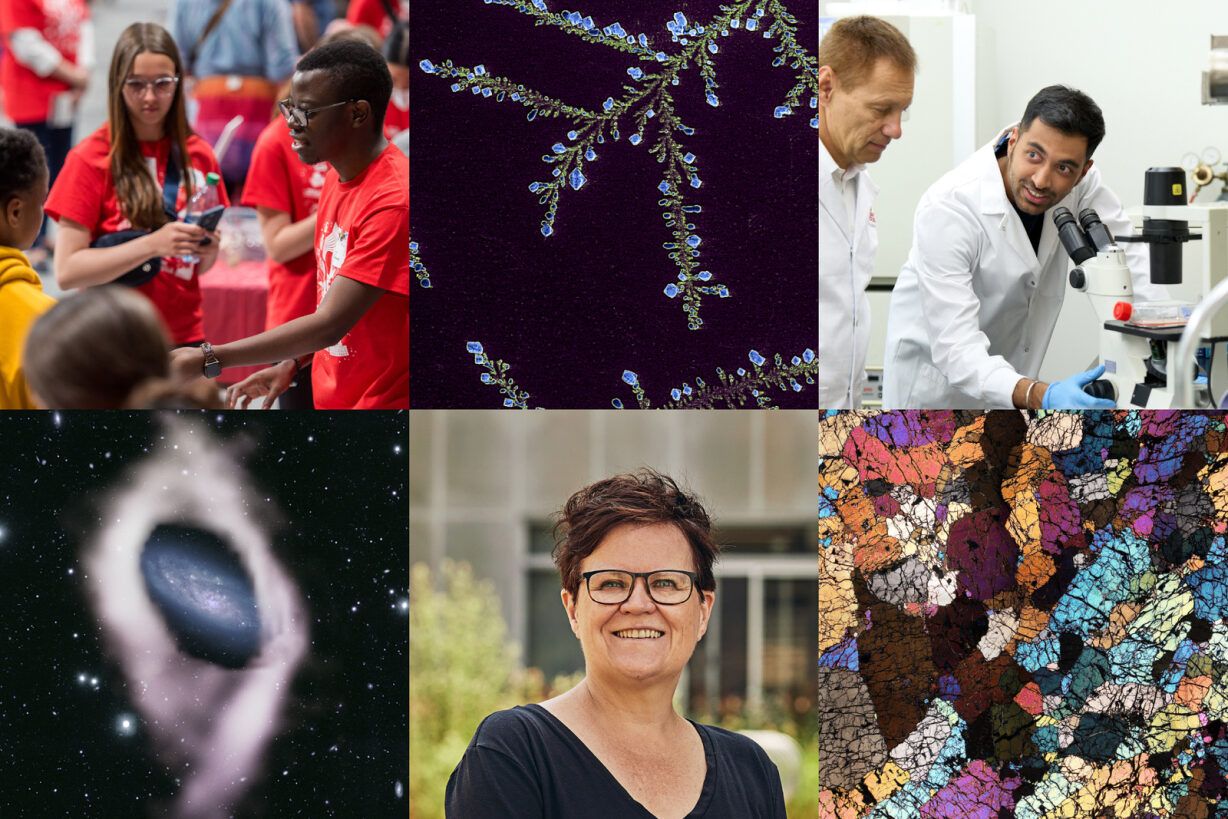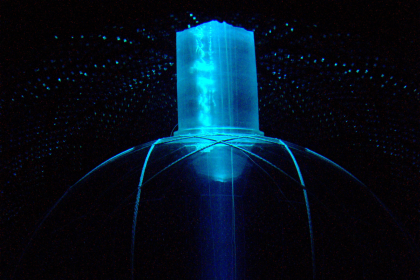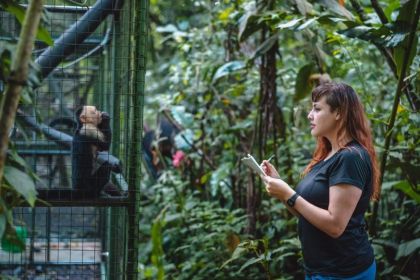
The year in research 2023
As we bid farewell to 2023, we’re taking a moment to remember some of the milestones, funding, awards, and discoveries that shaped the Queen’s research community this annum.
In May, Science Rendezvous Kingston saw its most successful event to date, with over 5,300 attendees and 400 volunteers engaging in science outreach activities. The full-day festival featured distinguished guests, including Arthur McDonald, 2015 Nobel laureate and Queen’s professor emeritus, and Alejandro Adem, President of the National Sciences and Engineering Research Council (NSERC) of Canada.
May also saw the community celebrate the wrap up of the WE-CAN Project, designed to empower and equip women entrepreneurs from underrepresented groups or sectors with the resources to take their businesses to the next level. Over three years, the program supported over 1,300 entrepreneurs in Kingston and the region, and due to its success, it will continue to offer programming to women in business.

V. Ophelia Rigault, EDI Speaker, Trainer & Consultant speaks at the WE-CAN Wrap-Up event.
This summer, Queen’s secured the position of 3rd globally and 1st in North America out of over 1,700 participating universities in the 2023 Times Higher Education Impact Rankings, marking its best performance to date. The rankings measure contributions to the United Nations’ Sustainable Development Goals through research, teaching, and outreach activity.
Research leadership
The prestigious NSERC John C. Polanyi Award was awarded to Cathleen Crudden (Chemistry) for her innovative work on protecting metal surfaces using organic molecules.
John Smol (Biology) was honoured for lifetime research achievements with the Vega Medal, the Nobel Prize-equivalent in geography, awarded by the King of Sweden. He was also recognized by the Royal Society of Canada with the Sir John William Dawson Medal and appointed to the Order of Ontario, for his groundbreaking work on protecting lakes and ecosystems.
The Canada Research Chair in Youth and African Urban Futures, Grace Adeniyi-Ogunyankin (Geography and Planning; Gender Studies) was named a Fellow of the Canadian Institute for Advanced Research’s new Humanity’s Urban Future program.
Funding future research
The Government of Canada pledged $105.7 million from the Canada First Research Excellence Fund to support a new interdisciplinary research initiative, Connected Minds: Neural and Machine Systems for a Healthy, Just Society. This collaborative project between Queen’s and York University is assessing the risks and benefits of technology for humanity.
In August, the Honourable Randy Boissonnault, Minister of Employment, Workforce Development and Official Languages, announced $23.9 million for Queen’s researchers across disciplines – advancing research from neutrino detection and climate action, to ensuring equal access in sport for Canadians with disabilities. The Queen’s funded projects include:
- Social Sciences and Humanities Research Council – Partnership: Amy Latimer-Cheung (Kinesiology and Health Studies) and Heather Aldersey (Rehabilitation Therapy) received more than $4 million in Partnership Grants from the Social Sciences and Humanities Research Council (SSHRC) to advance their work on equity and inclusion for people with disabilities.
- Social Sciences and Humanities Research Council – Insight: 30 Queen’s researchers were awarded over $3 million from SSHRC through Insight Development Grants, which support early research in its initial stages.
- Natural Sciences and Engineering Research Council – Discovery: $14.3 million in funding was awarded to advance innovative STEM and health research projects. In total, 43 Queen’s researchers were recipients of Discovery and RTI program grants.
- Canada Foundation for Innovation – John R. Evans Leaders Fund: $2 million in funding was announced to equip Queen’s researchers with leading-edge labs and equipment.
Additional funding that will support Queen’s future research includes:
- Nine Queen’s programs received $3 million from the federal government through the New Frontiers in Research Fund (NFRF).
- Queen’s secured over $15 million in support from the Canadian Institutes for Health Research’s Project Grant program to pioneer innovations and address critical health challenges. Research teams secured 12 of the competitive grants. CIHR also announced the recipients of their Team Grants with three projects led by Queen’s researchers receiving $5.71 million to advance innovative health research.
Breakthrough research that made headlines
This year, the Gazette published dozens of research profiles and stories highlighting new research discoveries and publications, many of which made headlines across Canada and internationally.
While the mysteries of dark matter continue to elude us and inspire new experiments, in April, the SNO+ experiment, captured neutrinos produced in nuclear reactors hundreds of kilometres away using pure water, for the first time.

The 12-metre diameter acrylic SNO+ detector is filled with 780 tonnes of liquid scintillator and surrounded by 10,000 photomultiplier light detectors. Queen's Art of Research Submission: "The SNO+ Detector" by Dr. Alex Wright, Faculty (Physics, Engineering Physics, and Astronomy) for the SNO+ Collaboration, SNOLAB.
In July, Ontario’s Crawford Lake caught the world’s attention when it was recommended as the geological landmark to mark the start of the Anthropocene. Brian Cumming (Biology) and his lab were part of the interdisciplinary research effort to champion the site, which represents the newest chapter in our planet’s narrative and a pivotal moment in our collective environmental history.
Scientists also cracked the code of what causes diamonds to erupt. Christopher Spencer (Geological Sciences and Geological Engineering) collaborated with a team of international researchers to examine the effects of global tectonic forces on these volcanic eruptions spanning the last billion years. With findings published in Nature, their discovery identified the breakup of tectonic plates as the driving force behind the generation and eruption of diamond-rich magma from deep inside the Earth.
September saw a group of international astronomers, including Nathan Deg and Kristine Spekkens (Physics, Engineering Physics & Astronomy), identify two potential polar ring galaxies – the type of galaxy that exhibits a ring of stars and gas perpendicular to its main spiral disk. These new findings suggest polar ring galaxies might be more common than previously believed.
Researchers from Queen’s and Environment and Climate Change Canada discovered that accelerated 21st-century warming has triggered a striking shift in algae composition in Great Slave Lake, North America’s deepest lake. The team’s findings, led by Kathleen Rühland (Paleoecological Environmental Assessment and Research Lab) and published in the journal Proceedings of the Royal Society B, suggest that declining ice coverage and other climate-related changes have marked the crossing of an important ecological threshold.
We continued our partnership with The Conversation Canada, the online news platform that pairs academic experts with experienced journalists to write informed content that can be shared and repurposed by media outlets worldwide. This year, 54 Queen’s researchers published 52 articles that garnered over 1.1 million reads. Some of our most popular articles covered topics like the impacts of ChatGPT, sustainable food systems, sexual health and wellness, as well as pay gaps and workplace productivity.
Mobilizing research
Queen’s aims to inspire emerging researchers, create research processes that are equitable and inclusive, and establish meaningful connections between academia and the wider community.
Our annual photo contest, Art of Research, showcased the beauty of research at Queen’s and recognized six outstanding winning photo and video entries. With a continued focus on the UN SDGs, the competition placed a spotlight on the intrinsic connection between research and social impact.

Queen's Art of Research Submission: "Returning the Gaze" by Siobhan Speiran, PhD Student (School of Environmental Studies), Proyecto Asis, Costa Rica.
In November, a delegation of Queen’s researchers traveled to Ottawa to participate in the 15th Canadian Science Policy Conference and discuss how the federal government can support major research facilities and transformative research programs. Panel participants engaged in thoughtful deliberations on what Canada needs to emerge as a global leader in science.
Autumn also saw Queen’s gear up for the launch of its total solar eclipse campaign, a once-in-a-lifetime event that will occur on April 8, 2024, with Kingston in the path of totality. Robert Knobel, head of the Department of Physics, Engineering Physics, and Astronomy is leading efforts to ensure the community can safely observe and learn about this rare celestial event.
This year, the university increased funding for undergraduate student research to bolster inquiry-based learning across various disciplines with an expansion of the Undergraduate Student Summer Research Fellowships (USSRF) and Undergraduate Student Research Awards (USRA) programs. With 178 positions supported, these programs provide enriching learning experiences that contribute to the development of future research leaders and innovators.
As move into 2024, we remain committed to creating the right conditions for research to thrive so we can remain at the forefront of academic excellence and societal impact.

